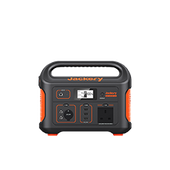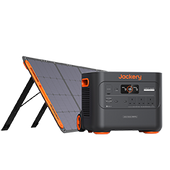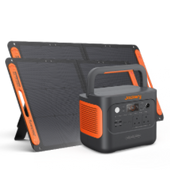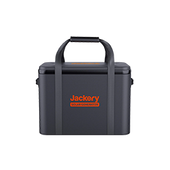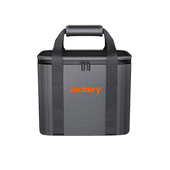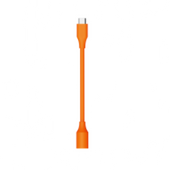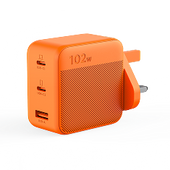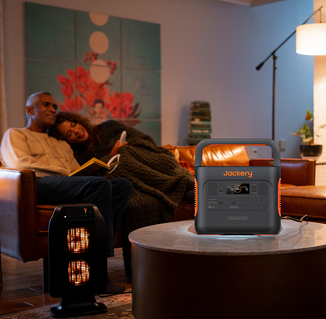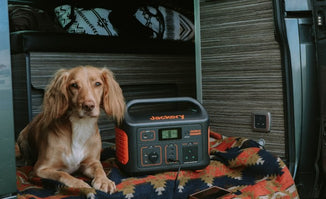The average household refrigerator consumes 250kWh of electricity annually and requires 200W of solar panels. A 100Ah battery would also be required as a reservoir to provide surplus current for the compressor motor and to power the refrigerator through the night when the solar panel is not producing power.
Alternatively, you can choose a solar generator with solar panels and a power station so that you do not need to find the appropriate inverter, battery, or charge controller to solar-power your refrigerator. Before disconnecting your refrigerator from the utility, however, you must determine how many solar panels and other solar power system components you require.
This comprehensive guide covers everything you need to know about solar panels for refrigerators. We highly recommend Jackery Portable Power Station to power your refrigerator or more appliances with solar energy, and the SolarSaga 200W solar panels are compatible with Jackery Portable Power Stations to power your refrigerator with high capacity.
 |
|
|
- Excellent solar conversion efficiency of 24.3% - IP67 waterproof rating - Foldable, convenient carrying - Built to last - 2 + 1 Years Warranty |
Can I Run A Refrigerator with Solar Power?
Yes, solar power can power various household appliances, including a standard refrigerator, a mini-fridge, or an RV refrigerator.
It would be best to have solar panels, a battery, an inverter, a charge controller, or only a solar generator to use solar power. Solar panels can transfer sunlight into electricity, but there is a power station or battery to store energy and power a refrigerator. A solar generator could be the best option to charge the refrigerator with solar power, which combines solar panels with a power station.

Solar energy is an excellent resource that is gaining in popularity daily. Solar power is never exhausted because it is a renewable energy source. Solar energy is environmentally friendly. It emits no carbon dioxide. In addition, solar energy can lessen your reliance on the utility and lower your electricity bill.
Although you can use solar power to charge a refrigerator, it is essential to know how many watts a refrigerator uses and how much solar energy is required, keep reading, and you will learn the answer.
How Many Solar Panels Do I Need to Run A Refrigerator?
How many solar panels to run the refrigerator? Solar panels are an effective method to lower your electricity bill and help the environment. However, how many solar panels are needed to fuel a fridge? Depending on the size of your refrigerator and the amperage of your solar panels, the number of solar panels required will vary.

Before determining how many solar panels are required to power a refrigerator, you must calculate the following:
- How many watts does a refrigerator use?
- How many watts do solar panels generate?
- How many peak sun hours do you receive?
- How much solar power does your refrigerator need?
How Many Watts Does A Refrigerator Use?
Most refrigerators in the United States include an EnergyGuide label that estimates their Annual Energy Consumption (kWh/year), which can be used to calculate their daily energy consumption (kWh/day).
For instance, this refrigerator's label indicates an "Estimated Annual Electricity Use" of 600 kWh. To calculate the daily energy consumption of this refrigerator, we divide its estimated annual energy consumption by 365 (the number of days in a year):
Estimated Daily Energy Consumption = 600 kWh ÷ 365 = 1.644 kWh/day = 1644 Wh/day
It is the easiest and quickest method, but you can also calculate your refrigerator's energy consumption using the manufacturer-supplied electrical specifications.
|
Product |
Size |
Annual Energy Consumption |
Daily Energy Consumption |
|
Small Fridge |
4.5 Cubic Feet |
237 kWh/year |
650 Wh/day (0.65 kWh/day) |
|
Middle Fridge |
12 Cubic Feet |
312 kWh/year |
850 Wh/day (0.85 kWh/day) |
|
Large Fridge |
27 Cubic Feet |
728 kWh/year |
2000 Wh/day (2 kWh/day) |
How Much Energy Does A Refrigerator Use?
Here is a reminder of the distinction between electrical power and electrical energy to avoid confusion:
Electrical power: measured in Watts (W) or kiloWatts (kW), represents the electricity consumption rate.
Electrical energy: measured in Watt-hours (Wh) or kiloWatt-hours (kWh), electrical energy is consumed over a given period. Power (Watts or kiloWatts) and Energy (Watt-hours or kiloWatt-hours) have the following relationship:
Energy Consumption (Wh) = Power Consumption (Watts) x Duration of Use (Hours).
For instance, if you have a 500W refrigerator that you use 8 hours per day, the daily energy consumption would be 500W x 8H = 4000Wh (4kWh).
As previously explained, a refrigerator's power consumption is the rate at which it consumes electricity. While older refrigerators can consume up to 700 Watts of power, newer, more energy-efficient models only consume 150-300 Watts.
You can find the power consumption (Watts) of your refrigerator on the manufacturer's nameplate or calculate it using other electrical specifications, such as its Amperage (Amps) and Voltage (Volts).
How Long Does A Refrigerator Run?
Refrigerators have operating cycles (Duty cycles), which means they do not operate continuously.
The compressor, the primary electrical component in a refrigerator, cycles ON and OFF to maintain a constant temperature within the appliance. The refrigerator's compressor must work harder to maintain the desired temperature whenever the ambient temperature rises, which causes power surges and increased duty cycles.
How Many Watts Does A Solar Panel Generate?
First, determine your solar panels' power yield. Under perfect conditions, a solar panel can provide up to its rated electricity. However, the actual production will vary. The actual wattage produced by your solar panels depends on several factors, including:
- Accessible sunlight
- Temperature
- Orientation and angle of your solar array
- Panel type (polycrystalline, monocrystalline, thin film)
- Solar panel productivity
All of the above factors affect the amount of electricity your solar panel will generate. Also, observe that some conditions can vary substantially throughout the day.
How Many Peak Sun Hours Do You Have?
In the solar industry, W/m2 (Watts per square meter) is the standard unit for measuring sunlight (Solar irradiance). Before a solar panel is assigned a Wattage rating, it is subjected to a series of tests known as "Standard Test Conditions" (or STCs for short).
These STCs contain a standard testing condition that replicates the amount of sunlight a solar panel would receive in ideal conditions: 1000 W/m2 (1 kW/m2).

Under these ideal conditions, a Peak Sun Hour is the energy the sun receives in one hour. Peak Sun Hours help us determine the amount of energy solar panels could produce in a given location.
Daily Energy Production (Wh) = Wattage of Solar Panels x Daily Peak Sun Hours
Reversely, and more importantly, for our purposes, you can use your region's daily peak sun hours to establish the size of the solar panel you require if you know how much daily energy the solar panels generate:
Wattage of Solar Panels = Required Daily Energy Production / Peak Daily Sun Hours
For instance, if you need to generate 600Wh of energy per day in an area that receives six hours of optimal sunlight daily, you will need a 100-Watt solar panel. (600Wh / 6 Sun Peak Hours) = 100W.
How Much Solar Power Does A Refrigerator Need?
To calculate the amount of solar energy required to operate a refrigerator, divide the refrigerator's daily energy consumption (in Watt-hours) by the number of Peak Sun Hours you receive daily, then multiply the result by 1.15 to account for system losses.
Solar Power Needed = (Estimated Daily Energy Consumption / Peak Sun Hours) x 1.15
For instance, if your refrigerator consumes approximately 2000Wh of energy per day and receives 5 hours of peak sunlight daily, you will need (2000Wh / 5H)*1.15 = 460W of solar power to operate your refrigerator.
|
Product |
Size |
Daily Energy Consumption (When refrigerator runs for 8 hours a day) |
Peak Sun Hours |
Solar Power Needed |
|
Small Fridge |
4.5 Cubic Feet |
650 Wh/day (0.65 kWh/day) |
5 |
150W |
|
Middle Fridge |
12 Cubic Feet |
850 Wh/day (0.85 kWh/day) |
6.5 |
150W |
|
Large Fridge |
27 Cubic Feet |
2000 Wh/day (2 kWh/day) |
6.5 |
350W |
What Size of Solar Panels Do I Need to Run A Refrigerator?
To determine what size of the solar panel to power a refrigerator, you must first determine how many amps the refrigerator draws. Multiply the voltage of your refrigerator by the amps it consumes; most refrigerators use approximately 13 amps. It will provide the wattage your refrigerator requires. Next, The number of solar panels necessary can then be calculated by dividing the wattage by the voltage.
Once you have determined the energy requirements for your refrigerator and any other electronic devices you intend to power with solar energy, you can assemble the appropriate solar panels. Choosing solar panels is relatively straightforward, mainly if you know your energy needs.
Using Jackery Solar Panels with Jackery Portable Power Stations will allow you to collect more energy. Designed with an industry-standard, Jackery Solar Panels are also compatible with power stations manufactured by third parties.
Lightweight and compact, Jackery solar panels are simple to transport wherever you go. The aesthetically pleasing panels and ergonomically designed handles can be installed in just one minute and are ideal for outdoor use. The solar power system is powered by eco-friendly, non-polluting, collapsible panels that can easily be assembled and transported.
SolarSaga 200W Solar Panel
The 200W Jackery SolarSaga Solar Panel has a solar conversion efficiency of up to 24.3%. The ETFE-coated case increases its durability, and the optimal angle for sunlight absorption makes it the ideal power source for outdoor travel and home backup.

It is foldable, transportable, and instantaneously connected to a power station, making it the ideal solar power system. With a power rating 200W, it offers the quickest solar charging experience among Jackery's current selection of solar panels. It has adjustable supports and is constructed with monocrystalline solar cells and a honeycomb light-trapping structure.
|
Product |
Jackery SolarSaga 200W Solar Panel |
||
|
Dimensions |
Folded: 21,2 x 24,2 x 1,6 in |
Unfolded: 21,2 x 91,3 x 1 in |
Weight: 17.5±0.5lbs |
|
Solar |
Peak Power: 200W |
Power Voltage: 18V |
Power Current: 11.12A |
|
Efficiency |
24.3% |
||
|
Compatible With (Capacity & Recharging Time) |
Explorer 3000 Pro + 6*SolarSaga 200W: 2856Wh (2.8H Recharging) Explorer 2000 Pro + 6*SolarSaga 200W: 2346Wh (2.3H Recharging) Explorer 1500 Pro + 6*SolarSaga 200W: 1836Wh (1.8H Recharging) Explorer 1500 + 2*SolarSaga 200W: 1870Wh (5.5H Recharging) Explorer 1000 Pro + 4*SolarSaga 200W: 1224Wh (1.8H Recharging) Explorer 1000 + 1*SolarSaga 200W: 1530Wh (9H Recharging) Explorer 500 + 1*SolarSaga 200W: 639Wh (9H Recharging) Explorer 300 + 1*SolarSaga 200W: 405Wh (5H Recharging) Explorer 240 + 1*SolarSaga 200W: 305Wh (5H Recharging) |
||
|
200-600W Refrigerator Working Hours
|
Explorer 3000 Pro + 6*SolarSaga 200W: 4-12H Explorer 2000 Pro + 6*SolarSaga 200W: 3.3-10H Explorer 1500 Pro + 6*SolarSaga 200W: 2.6-7.8H Explorer 1500 + 2*SolarSaga 200W: 2.6-7.9H Explorer 1000 Pro + 4*SolarSaga 200W: 1.7-5.2H Explorer 1000 + 1*SolarSaga 200W: 2.2-6.5H Explorer 500 + 1*SolarSaga 200W: 0.9-2.7H Explorer 300 + 1*SolarSaga 200W: 0.6-1.7H Explorer 240 + 1*SolarSaga 200W: 0.4-1.3H |
||
SolarSaga 100W Solar Panel
This monocrystalline Jackery SolarSaga 100W Solar Panel converts solar energy into renewable energy. It is ideal for outdoor activities and power disruptions due to its high solar conversion efficiency of 24.3%.

The ETFE-laminated case extends the solar panel's lifespan and weighs only 10.33 lb. It is compact, lightweight, IP65 waterproof-rated, and simple to transport for off-grid adventures. The solar panels are fitted with adjustable supports, and their efficiency can reach up to 24.3%. Make the most of solar energy on sunny days.
So if you choose the SolarSaga 100W solar panels to power a refrigerator, you must combine SolarSaga 100W solar panels with Jackery Portable Power Stations. For example, 6*SolarSaga 100W solar panels with an Explorer 3000 Pro will power a refrigerator for over 19.5 hours, which could be the best home backup power in emergencies.
|
Product |
Jackery SolarSaga 100W Solar Panel |
||
|
Dimensions |
Folded: 24 x 21 x 1.4 in |
Unfolded: 48 x 21 x 0.2 in |
Weight: 10.33 lbs |
|
Solar |
Peak Power: 100W |
Power Voltage: 18V |
Power Current: 5.55A |
|
Efficiency |
24.3% |
||
|
Compatible With (Capacity & Recharging Time) |
Explorer 3000 Pro + 6*SolarSaga 100W: 4590Wh (9H Recharging) Explorer 2000 Pro + 6*SolarSaga 100W: 2805Wh (5.5H Recharging) Explorer 1500 Pro + 6*SolarSaga 100W: 2040Wh (4H Recharging) Explorer 1500 + 4*SolarSaga 100W: 1870Wh (5.5H Recharging) Explorer 1000 Pro + 4*SolarSaga 100W: 1292Wh (3.8H Recharging) Explorer 1000 + 2*SolarSaga 100W: 1700Wh (10H Recharging) Explorer 500 + 1*SolarSaga 100W: 639Wh (9H Recharging) Explorer 300 + 1*SolarSaga 100W: 405Wh (5H Recharging) Explorer 240 + 1*SolarSaga 100W: 305Wh (5H Recharging) |
||
|
200-600W Refrigerator Working Hours
|
Explorer 3000 Pro + 6*SolarSaga 100W: 6.5-19.5H Explorer 2000 Pro + 6*SolarSaga 100W: 4-11.9H Explorer 1500 Pro + 6*SolarSaga 100W: 2.9-8.7H Explorer 1500 + 2*SolarSaga 100W: 2.6-7.9H Explorer 1000 Pro + 4*SolarSaga 100W: 1.8-5.5H Explorer 1000 + 1*SolarSaga 100W: 2.4-7.2H Explorer 500 + 1*SolarSaga 100W: 0.9-2.7H Explorer 300 + 1*SolarSaga 100W: 0.6-1.7H Explorer 240 + 1*SolarSaga 100W: 0.4-1.3H |
||
SolarSaga 80W Solar Panel
The Jackery SolarSaga 80W monocrystalline solar panel's rear panel is constructed with extra-white glass, increasing conversion efficiency to an industry-leading 25%. The solar panel weighs just 11 pounds, making it ideal for outdoor activities and emergency power disruptions.

The first photovoltaic product was certified by TÜV SÜD. It is according to the esteemed IEC TS63163 standard. 15 professional testing were conducted to check these industrial-grade photovoltaic materials. The solar panel is made of 2.8mm low iron full toughened glass, making it exceedingly durable.
To power a refrigerator with solar power, expect SolarSaga 200W and 100W solar panels; there is the SolarSaga 80W solar panels. Usually, these solar panels are used in camping, RVing, or off-grid living. For example, you can power a 200W portable fridge for about 8 hours with 2*SolarSaga 80W and an Explorer 1500 power station.
|
Product |
Jackery SolarSaga 80W Solar Panel |
||
|
Dimensions |
Folded: 35.67 x 20.79 x 1.06 in |
Unfolded: 35.67 x 20.79 x 1.06 in |
Weight: 10.33 lbs |
|
Solar |
Peak Power: 80W |
Power Voltage: 22V |
Power Current: 3.6A |
|
Efficiency |
25% |
||
|
Compatible With (Capacity & Recharging Time) |
Explorer 1500 Pro + 12*SolarSaga 80W: 1795.2Wh (2.2H Recharging) Explorer 1500 + 4*SolarSaga 80W: 1904Wh (7H Recharging) Explorer 1000 Pro + 12*SolarSaga 80W: 1468.8Wh (1.8H Recharging) Explorer 1000 + 1*SolarSaga 80W: 1156Wh (17H Recharging) Explorer 500 + 1*SolarSaga 80W: 629.8Wh (9.4H Recharging) Explorer 300 + 1*SolarSaga 80W: 353.8Wh (5.8H Recharging) Explorer 240 + 1*SolarSaga 80W: 305Wh (5H Recharging) |
||
|
200-600W Refrigerator Working Hours
|
Explorer 1500 Pro + 6*SolarSaga 80W: 2.5-7.6H Explorer 1500 + 2*SolarSaga 80W: 2.7-8H Explorer 1000 Pro + 4*SolarSaga 80W: 2-6.2H Explorer 1000 + 1*SolarSaga 80W: 1.6-4.9H Explorer 500 + 1*SolarSaga 80W: 0.9-2.7H Explorer 300 + 1*SolarSaga 80W: 0.5-1.5H Explorer 240 + 1*SolarSaga 80W: 0.4-1.3H |
||
What Size of Solar Generator Do I Need to Run A Refrigerator?
A portable solar generator is ideal for using solar energy to power a refrigerator and other appliances. It is much more important for home or off-grid use because it allows you to charge most of your devices.
Jackery is a well-known manufacturer of high-quality solar equipment, including solar panels, power stations, and solar generators. Jackery Solar generators convert solar energy into electricity using solar panels and store the point in a portable power station. Jackery's solar generators provide clean and dependable backup power for camping, RVs, and residential backup systems.

Jackery solar generators are renowned for their durability, portability, and originality in the international market. Numerous AC outlets, DC carports, and USB charging terminals power your devices. The pass-through charge function permits simultaneous appliance and power station charging simultaneously.
Determine your refrigerator's required volts before choosing the proper size solar generator. You can select from Jackery Solar Generators with capacities ranging from 2160Wh to 240Wh based on the power requirements of your appliances. Here is how to calculate how long your refrigerator will run:
Working time = solar generator capacity * 0.85 / wattage of your device
For instance, charging a 600W refrigerator with a Jackery Solar Generator 2000 Plus (2042.8Wh capacity) will take 3 hours (2042.8Wh*0.85/600W).
|
Series |
Capacity |
Ports |
Recharging Time |
Working Hours |
|
2042.8Wh |
3*AC Output: 230V~ 50Hz, 3000W Max, 6000W surge peak 2*USB-A Output: Quick Charge 3.0, 18W Max 2*USB-C Output: 100W MAX 1*Car Port: 120W (12V/10A) |
6*SolarSaga 200W: 1.4H |
Single Door Large Refrigerator(200W): 8.2H Double Door Large Refrigerator(600W): 2.7H Refrigerator(500W): 3.3H Minifridge(65W): 25.1H Freezer(100W): 16.3H |
|
|
Wall Charging: 2H |
||||
|
Car Charging: 24H |
||||
|
1512Wh (43.2V, 35Ah) |
3*AC Output: 120V~ 60Hz 1800W (3600W Peak) 2*USB-A Output: Quick Charge 3.0*2, 18W Max 2*USB-C Output: 100W MAX 1*Car Port: 120W (12V/10A) |
6*SolarSaga 200W: 1.8H |
Single Door Large Refrigerator(200W): 6H Double Door Large Refrigerator(600W): 2H Refrigerator(500W): 2.4H Minifridge(65W): 18.6H Freezer(100W): 12.1H |
|
|
Wall Charging: 3.5H |
||||
|
Car Charging: 2.5H |
||||
|
1,002Wh |
1*USB-A 18W Max 2*USB-C Output PD 100W MAX 1*Car Port 120W (12V/10A) 3*AC Output (1000W, 2000W Surge Peak) |
4*SolarSaga 200W: 1.8H |
Single Door Large Refrigerator(200W): 4H Double Door Large Refrigerator(600W): 1.3H Refrigerator(500W): 1.6H Minifridge(65W): 12.3H Freezer(100W): 8H |
|
|
Wall Charging: 1.8H |
||||
|
Car Charging: 12H |
Solar Panel for Refrigerator FAQs
The following are the frequently asked questions about solar panels for refrigerators:
-
Can a 200W solar panel run a refrigerator?
Of course, you can use a 200W solar panel to power a refrigerator, but you should combine it with a portable power station.
The ability of a 200W solar panel to power a refrigerator depends on the size and efficacy of the fridge. Refrigerators typically consume between 200 and 600 watts. If you choose Jackery SolarSaga 200W solar panels, you should be paired with a Jackery Portable Power Station to use solar energy fully.
For example, if you combine a 200W solar panel with an Explorer 2000 Pro, you will have a higher 2160Wh capacity, which can power your 200W refrigerator for about 9.18 hours. Check the following detailed information.
|
Compatible with |
Capacity |
Refrigerator Watts |
Working Hours |
|
Explorer 2000 Pro |
2465Wh |
200W-600W |
3.5-10.5H |
|
Explorer 1500 Pro |
1700Wh |
200W-600W |
4.6-13.7H |
|
Explorer 1000 Pro |
1224Wh |
200W-600W |
4.6-13.7H |
|
Explorer 500 |
639Wh |
200W-600W |
4.6-13.7H |
|
Explorer 300 |
405Wh |
200W-600W |
4.6-13.7H |
-
How many solar panels do I need to run a 12V fridge?
Most individuals will require 100W to 200W solar panels to power a 12V portable refrigerator, which should power your refrigerator for camping, RVing, and boating excursions.
Usually, a 12V fridge has 30 Amps, according to the formula:
Watts = Volts x Amps
However, suppose you intend to use solar power to charge your camping, RV, or off-grid refrigerators. In that case, you may choose Jackery SoloarSaga 100W or 200W with relatively low-capacity Explorer portable power stations.
For instance, Explorer 1000 portable power station with a 200W solar panel (1530Wh) powers a 12V portable fridge for about 3.6 hours, or 2*SolarSaga 100W with Explorer 1000 (1700Wh) can power 4 hours. You can check our web for more details based on your requirements and usages in Jackery Solar Panel.
-
How to make my refrigerator more energy efficient?
It is possible to reduce your refrigerator's daily energy consumption. These suggestions will make your refrigerator more energy-efficient and reduce your monthly electric bill:
- Keep the refrigerator well-stocked. When a fridge is empty, it requires more energy to chill itself than when it is complete.
- From time to time, defrost your freezer; this enhances the appliance's efficiency. When frost reaches a thickness of 1/4 inch, it is time to get to work.
- Cover all liquids and stews placed in the refrigerator. They emit moisture, which increases the load on the refrigerator's compressor.
Final Thoughts
The refrigerator is the most demanding working household appliance. It preserves our food frozen and fresh 24 hours per day, seven days per week. Since the refrigerator accounts for between 5 and 10 percent of your annual electricity bill, running it on solar power is highly enticing.
This detailed guide will help you to figure out how many solar panels you need to run a refrigerator, how many watts it uses, and how much solar power it requires. Jackery Solar Generators combine solar panels with power stations to power your refrigerator with high capacity. Just pick one for your home or an off-grid cabin.





